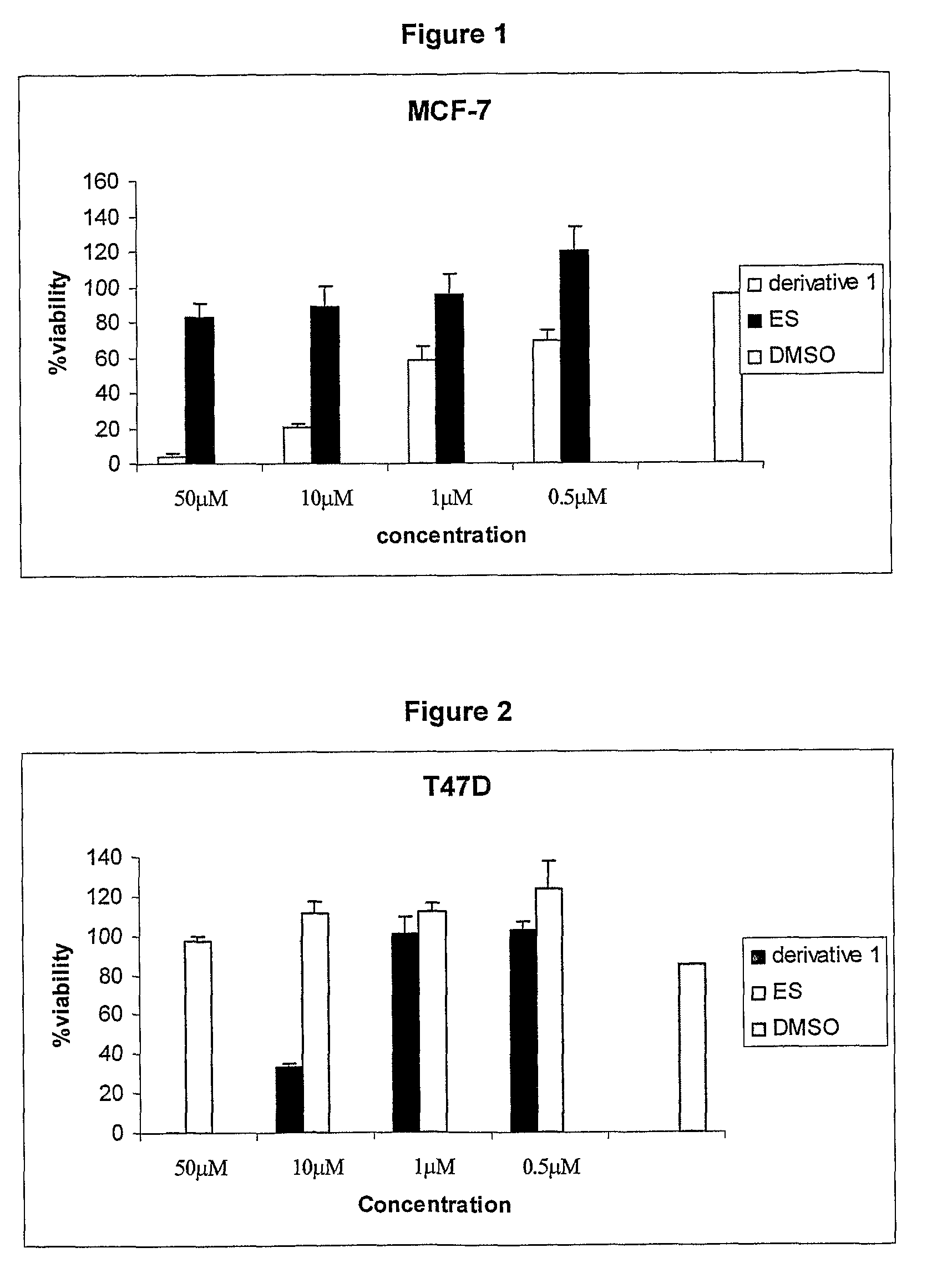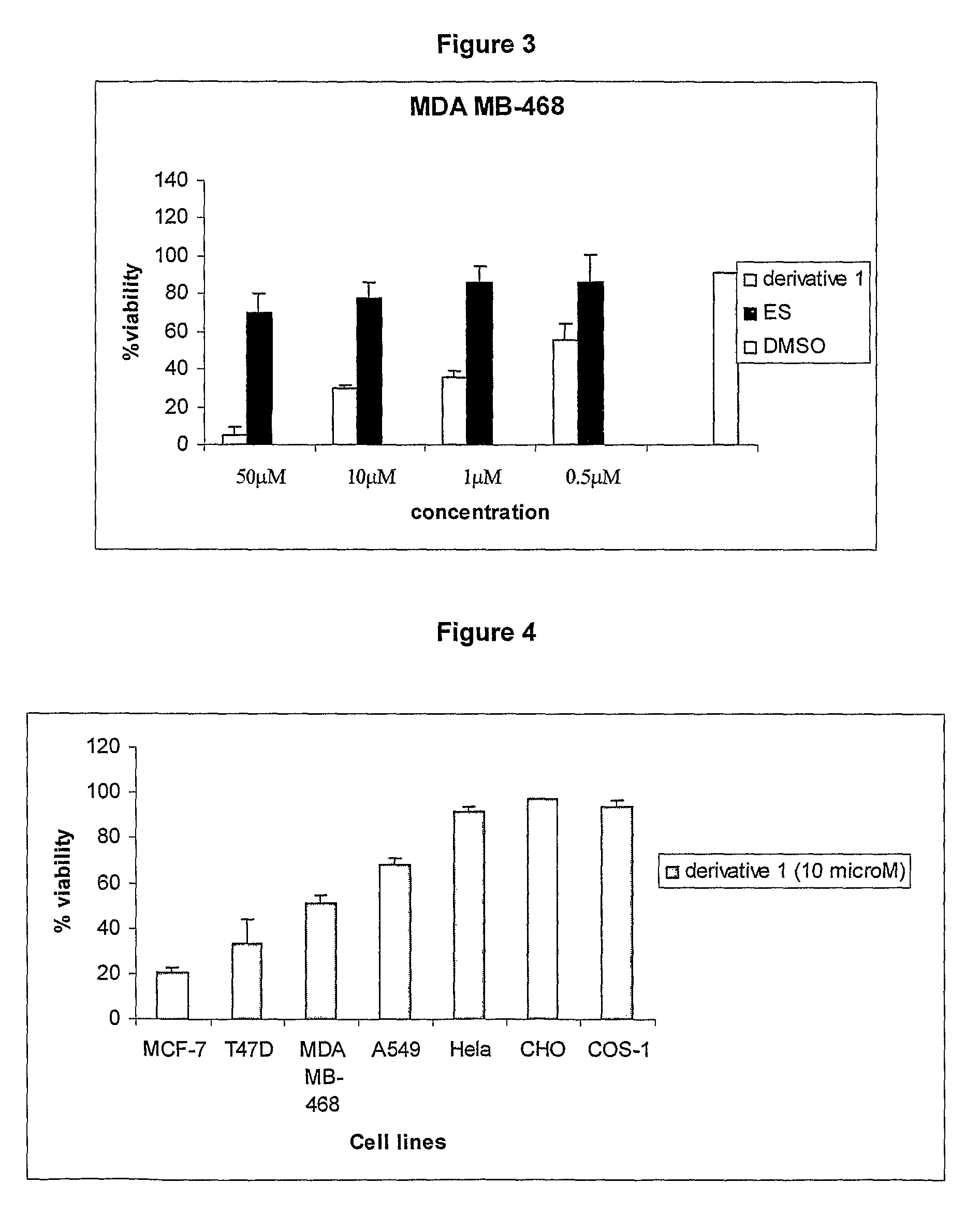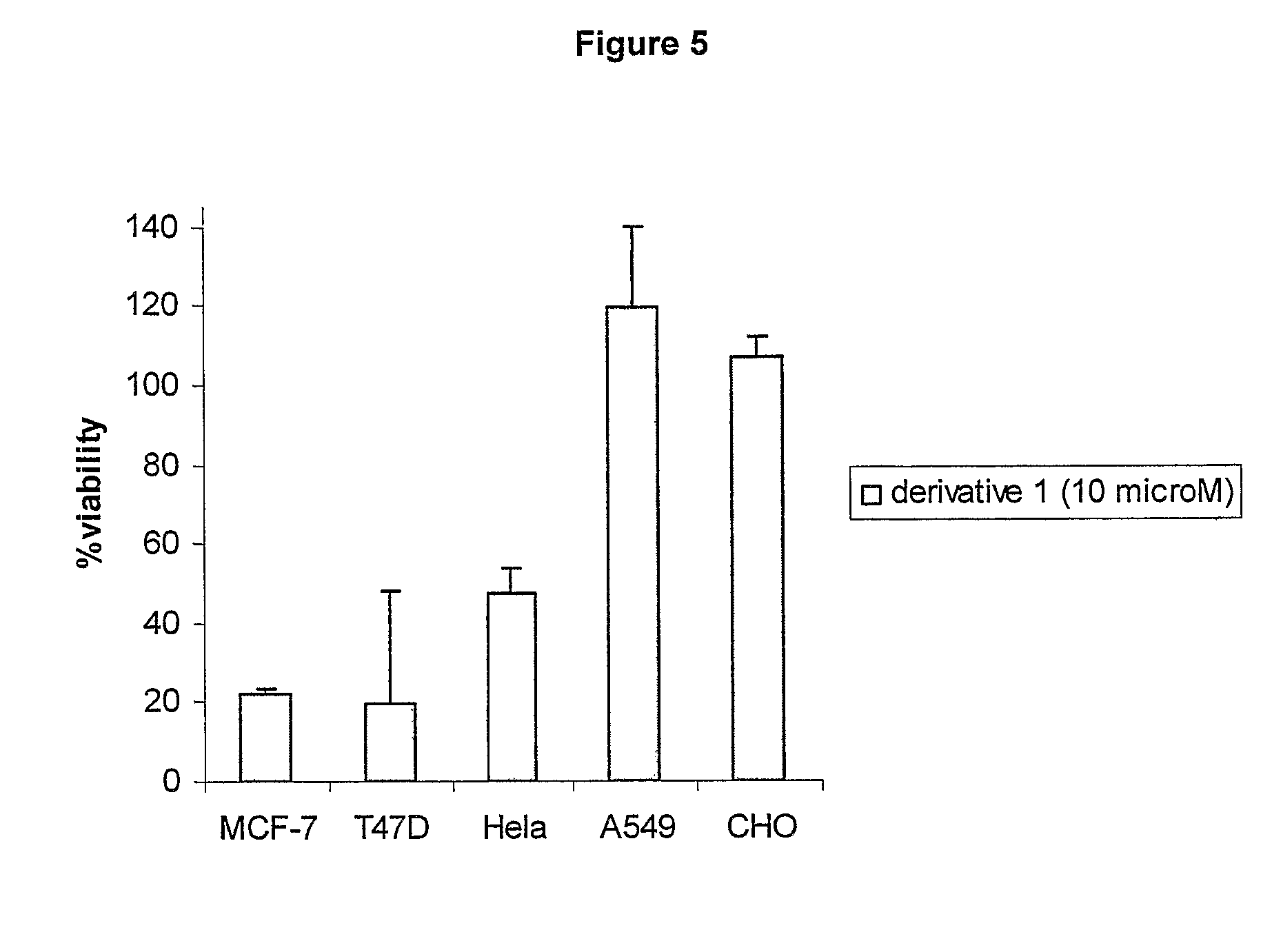Cationic 17 α-substituted-estradiol derivatives useful as anti-cancer agent
a technology of estradiol and derivatives, which is applied in the direction of biocide, drug compositions, organic chemistry, etc., can solve the problems of irreparable cytotoxicity in humans and recurrence of diseas
- Summary
- Abstract
- Description
- Claims
- Application Information
AI Technical Summary
Benefits of technology
Problems solved by technology
Method used
Image
Examples
example 1
Synthesis of the Cationic Estradiol Derivative 1 (Scheme 1)
Step A: Synthesis of 3-tert butyldimethylsilyloxy Estrone
[0093]To a solution of estrone (a) (1 g, 3.69 mmoles) in dry DCM & dry DMF (9:1 v / v), 1.18 g (11.09 mmoles) of 2,6 Lutidine and 0.93 ml (4.06 mmoles) of TBDMS-triflate at 0° C. was added. The reaction mixture was stirred at room temperature for 30 min. The reaction mixture was taken in 20 ml of dichloromethane, washed with saturated NaHCO3 solution (1×20 ml), water (2×20 ml) and brine (1×20 ml) The non-aqueous solvent was finally dried with anhydrous Na2SO4 and dried in vacuum. Column chromatographic purification (using 60-120 mesh silica gel and 2% ethyl acetate in hexane as eluting solvent mixture) of the dried residue afforded a1 as a white solid (1.01 g, 71% yield, Rf 0.4 in 10% ethyl acetate in hexane).
[0094]1H NMR (300 MHz, CDCl3): δ=0.19 [s, 6H, Si(CH3)2], 0.9 [s, 3H, 18-CH3], 1.0 [s, 9H, SiC(CH3)3], 1.4-1.7 and 1.9-2.55 [m, 13H, cyclopentane and cyclohexane rin...
example 2
Synthesis of the Cationic Estradiol Derivative 2
[0111]Steps A-D are same as shown for the synthesis of derivative 1 (or structure 1).
Step E: Synthesis of 3-tertbutyldimethylsilyloxy-17α-[3N,Ndihexadecyl (amino)propane]-17β-estradiol
[0112]The crude aldehyde prepared in the step-D (in Example-1), (500 mg, 1.13 mmoles) and N,N-di-octadecylylamine (558 mg, 1.4 mmoles) was dissolved in 10 mL dichloromethane and was stirred for 0.5 h under nitrogen in room temperature. Sodium cyanoborohydride (283 mg, 4.50 mmoles) was added to the reaction mixture and the stirring was continued further for 24 h under nitrogen atmosphere. The reaction mixture was concentrated and the residue upon column chromatographic purification (using 60-120 mesh size silica gel and hexane / ethyl acetate (80:20) as eluent) afforded the title compound, 321 mg (57.3%) as semisolid.
[0113]1H NMR (300 MHz, CDCl3): =0.19 [s, 6H, Si(CH3)2], 0.87-0.93 [m, 9H, 18-CH3, N—(CH2—(CH2)14—CH3)2], 0.99 [s, 9H, SiC(CH3)3], 1.2-2.3 [m, 7...
example 3
Synthesis of the Cationic Estradiol Derivative 3
[0120]Steps A-D are same as shown for the synthesis of derivative 1 (or structure 1).
Step E: Synthesis of 3-tertbutyldimethylsilyloxy-3N,N-diethyl(methyl)aminopropane-17β-estradiol
[0121]The crude aldehyde prepared in step-E (in example 1), (500 mg, 1.13 mmoles) and N,N-di-diethyl amine (90 mg, 1.23 mmoles) was dissolved in 10 mL dichloromethane and was stirred for 0.5 h under nitrogen in room temperature. Sodium cyanoborohydride (283 mg, 4.50 mmoles) was added to the reaction mixture and the stirring was continued further for 24 h under nitrogen atmosphere. The reaction mixture was concentrated and the residue upon column chromatographic purification (using 60-120 mesh size silica gel and hexane / ethyl acetate (80:20) as eluent) afforded the title compound, 180 mg (36.01%) as semisolid.
[0122]1H NMR (300 MHz, CDCl3): =0.19 [s, 6H, Si(CH3)2], 0.87-0.93 [m, 9H, 18-CH3, N—(CH2—CH3)2], 0.99 [s, 9H, SiC(CH3)3], 1.2-2.3 [m, 16H, cyclopentane, ...
PUM
| Property | Measurement | Unit |
|---|---|---|
| temperature | aaaaa | aaaaa |
| molar ratio | aaaaa | aaaaa |
| molar ratio | aaaaa | aaaaa |
Abstract
Description
Claims
Application Information
 Login to View More
Login to View More - R&D
- Intellectual Property
- Life Sciences
- Materials
- Tech Scout
- Unparalleled Data Quality
- Higher Quality Content
- 60% Fewer Hallucinations
Browse by: Latest US Patents, China's latest patents, Technical Efficacy Thesaurus, Application Domain, Technology Topic, Popular Technical Reports.
© 2025 PatSnap. All rights reserved.Legal|Privacy policy|Modern Slavery Act Transparency Statement|Sitemap|About US| Contact US: help@patsnap.com



